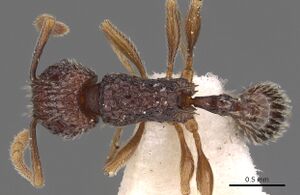Tetramorium flabellum
| Tetramorium flabellum | |
|---|---|

| |
| Scientific classification | |
| Kingdom: | Animalia |
| Phylum: | Arthropoda |
| Class: | Insecta |
| Order: | Hymenoptera |
| Family: | Formicidae |
| Subfamily: | Myrmicinae |
| Tribe: | Crematogastrini |
| Genus: | Tetramorium |
| Species: | T. flabellum |
| Binomial name | |
| Tetramorium flabellum Bolton, 1980 | |
A rainforest species. Tetramorium flabellum have been found in rotten logs and once under a stone, presumably from their nests. Specimens have also been collected in leaf litter samples.
Identification
Bolton (1980) - The spectacular bizarre pilosity of T. flabellum will immediately differentiate the species from all other known members of genus Tetramorium in the Ethiopian region.
Keys including this Species
- Key to Afrotropical Tetramorium species groups
- Key to Afrotropical Tetramorium ericae osiris inezulae gabonensis species groups
- Key to Afrotropical Tetramorium flabellum species group
Distribution
Latitudinal Distribution Pattern
Latitudinal Range: 6.417222222° to 5.666666667°.
| North Temperate |
North Subtropical |
Tropical | South Subtropical |
South Temperate |
- Source: AntMaps
Distribution based on Regional Taxon Lists
Afrotropical Region: Cameroun, Central African Republic, Democratic Republic of Congo, Gabon, Ghana (type locality), Ivory Coast.
Distribution based on AntMaps
Distribution based on AntWeb specimens
Check data from AntWeb
Countries Occupied
| Number of countries occupied by this species based on AntWiki Regional Taxon Lists. In general, fewer countries occupied indicates a narrower range, while more countries indicates a more widespread species. |

|
Estimated Abundance
| Relative abundance based on number of AntMaps records per species (this species within the purple bar). Fewer records (to the left) indicates a less abundant/encountered species while more records (to the right) indicates more abundant/encountered species. |

|
Biology
Castes
Worker
Images from AntWeb
   
| |
| Holotype of Tetramorium flabellum. Worker. Specimen code casent0901201. Photographer Ryan Perry, uploaded by California Academy of Sciences. | Owned by NHMUK, London, UK. |

| |
| Worker. Specimen code casent0426048. Photographer Will Ericson, uploaded by California Academy of Sciences. | Owned by CAS, San Francisco, CA, USA. |
Nomenclature
The following information is derived from Barry Bolton's Online Catalogue of the Ants of the World.
- flabellum. Tetramorium flabellum Bolton, 1980: 298 (w.) GHANA.
Unless otherwise noted the text for the remainder of this section is reported from the publication that includes the original description.
Description
Worker
Holotype. TL 3.0, HL 0.74, HW 0.65, CI 88, SL 0.62, SI 95, PW 0.48, AL 0.90. Paratypes (12 measured): TL 2.9-3.2, HL 0.72-0.78, HW 0.62-0.68, CI 86-89, SL 0.62-0.66, SI 94-100, PW 0.46-0.50, AL 0.86-0.96. Maximum diameter of eye 0.13-0.14, about 0.19-0.21 x HW.
Mandibles longitudinally striate. Anterior clypeal margin entire. Median clypeal carina strong, with a few weaker rugulae arising from it and running posterolaterally. Lateral portions of clypeus strongly raised into a very conspicuous shield in front of each antennal insertion. Frontal carinae strong, reaching back to occipital region where they merge with the rugoreticulum present there. Antennal scapes relatively long, SI in range 94-100 (95 in holotype). Antennal scrobes narrow and shallow. Maximum diameter of eye 0.13, about 0.20 x HW. Propodeal spines long and strong, feebly sinuate in profile, much longer than the broad, acutely triangular metapleural lobes. Petiole node in profile rectangular, the dorsal length slightly greater than the height of the tergal portion. In dorsal view the petiole node slightly longer than broad. Dorsum of head predominantly longitudinally rugose to level of posterior margins of eyes, with few or no cross-meshes to this level. Behind the level of the eyes with a strong rugoreticulum which extends to the occipital margin. Sides of head uniformly reticulate-rugose except in scrobal area where the sculpture is interrupted directly below the frontal carinae. Dorsal surfaces of alitrunk and pedicel segments reticulate-rugose, feebler on the postpetiole than on the petiole. Ground-sculpture everywhere on the dorsum vestigial, at most a few superficial punctulae between the rugose meshes. First gastral tergite unsculptured. Pilosity bizarre and highly characteristic. Each main hair on the dorsum of the head and body consisting of a short basal shaft, from the apex of which radiate 9-12 branches in a flat plane, reminiscent of the ribs of an open fan. Dorsal surfaces of middle and hind tibiae with dense but short decumbent pubescence only. Colour dark brown.
Paratype: As holotype but Ivory Coast paratypes somewhat lighter brown than those from Ghana. Shape of propodeal spines variable, commonly slightly downcurved or feebly sinuate along their length, more rarely approximately straight.
Type Material
Holotype worker, Ghana: Tafo, 3.ix.1970, rotten log (B. Bolton) (The Natural History Museum). Paratypes. Ghana: 6 workers with same data as holotype; 1 worker same locality but 31.viii.1970, litter sample (B. Bolton). Ivory Coast: 5 workers, Forét de Tai, 9.viii.1975, no. 4 (T. Diomande) (BMNH; Museum of Comparative Zoology; Naturhistorisches Museum, Basel).
References
References based on Global Ant Biodiversity Informatics
- Levieux J., and T. Diomande. 1985. Evolution des peuplements de fourmis terricoles selon l'age de la végétation dans une foret de Cote d'Ivoire intacte ou soumise à l'action humaine. Insectes Sociaux 32(2): 128-139.

